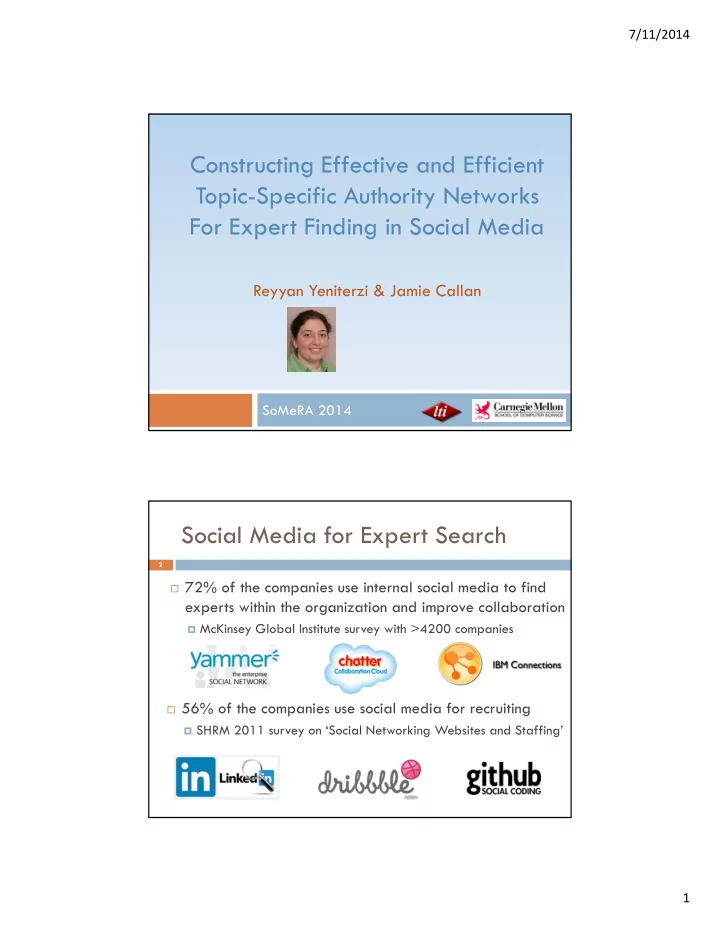

7/11/2014 Constructing Effective and Efficient Topic-Specific Authority Networks For Expert Finding in Social Media Reyyan Yeniterzi & Jamie Callan SoMeRA 2014 Social Media for Expert Search 2 72% of the companies use internal social media to find experts within the organization and improve collaboration McKinsey Global Institute survey with >4200 companies 56% of the companies use social media for recruiting SHRM 2011 survey on ‘Social Networking Websites and Staffing’ 1
7/11/2014 Expert Retrieval Background 3 Expert Finding Task TREC Enterprise Track 2005-2008 W3C and CSIRO Collections State-of-the-art Approaches Profile-based Models [Balog, 2006] Document-based Models [Balog, 2006; Macdonald, 2006] Graph-based Models [Serdyukov, 2008] Learning-based Models [Fang, 2010] Expert Retrieval in Social Media 4 Is writing topic-specific content enough for being considered an expert ? One also needs to have topic-specific influence over other users authority estimation user authority networks reading, commenting or voting 2
7/11/2014 Outline 5 Authority-based approaches PageRank [Brin and Page, 1998] Topic-Sensitive PageRank [Haveliwala, 2002] HITS [Kleinberg, 1999] Topic-Candidate Graphs Experiments Finding topic-specific expert bloggers Conclusion PageRank (PR) [Brin and Page, 1998] 6 Graph topic-independent all users all user activities over all documents 3
7/11/2014 Topic-Sensitive PageRank (TSPR) [ Haveliwala, 2002] 7 the PageRank graph TSPR Approach PageRank approach + Teleportation is possible only to users that are associated with topic-relevant content Query Hyperlink-Induced Topic Search (HITS) [Kleinberg, 1999] 8 Hub: Sum of authority scores of outgoing edges Authority: Sum of hub scores of incoming edges Hub Authority Applied to more topic-specific authority networks to focus the computational effort on relevant nodes 4
7/11/2014 Constructing HITS Graph 9 Step 1: Retrieve an initial list of expert candidates, which is called the root set Query Constructing HITS Graph 10 Step 2 : Expand root set into base set, which consists of users who are connected to/from users in the root set 5
7/11/2014 Constructing HITS Graph 11 Step 3 : Use all users in base set as nodes and all existing interactions among them as edges Graph Properties: Nodes & Edges 12 PageRank Graph HITS Graph 6
7/11/2014 HITS on web pages 13 ______ ______ ______ ______ ______ ______ ______ ______ ______ ______ ______ ______ ______ ______ ______ ______ ______ ______ ______ ______ ______ ______ ______ ______ HITS on users 14 ______ ______ ______ ______ ______ ______ ______ ______ ______ ______ ______ ______ ______ ______ ______ ______ ______ ______ ______ ______ ______ ______ ______ ______ 7
7/11/2014 HITS on users 15 ______ ______ ______ ______ ______ ______ ______ ______ ______ ______ ______ ______ ______ ______ ______ ______ ______ ______ ______ ______ ______ ______ ______ ______ Topic-Candidate (TC) graphs 16 ______ ______ ______ ______ ______ ______ ______ ______ ______ ______ ______ ______ ______ ______ ______ ______ ______ ______ ______ ______ ______ ______ ______ ______ 8
7/11/2014 Constructing Topic-Candidate Graph 17 Step 1: Retrieve an initial list of expert candidates, which is called the root set Query Constructing Topic-Candidate Graph 18 Step 2 : Expand root set into base set, which consists of users who are connected to/from users in root set due to topic-relevant interactions 9
7/11/2014 Comparison of Graphs 19 PageRank Graph Topic-Candidate Graph HITS Graph Experiments Finding topic-specific expert bloggers Reading and commenting activity as authority signals 10
7/11/2014 Dataset 21 Intra-organizational blog collection from a large multinational IT firm # Posts 165,414 # Comments 783,356 # Employees >100,000 # Posters 20,354 # Commenters 42,169 # Readers 92,360 Access logs cover 44 of the 56 months of the collection Evaluation Data 22 40 work related topics Selected from the access logs of company search engine Created by the company employees Candidate Pools Top 10 candidates retrieved from content-based approaches Assessments – (The collection is not public) Performed by author Yeniterzi 4-point scale not an expert, some expertise, an expert, very expert 11
7/11/2014 Authority Networks 23 Reading Commenting Content-based Experiments 24 NDCG NDCG NDCG @1 @3 @10 Profile [Balog, 2006] .7000 .6689 .6494 Votes [MacDonald, 2006] .3667 .4090 .4140 ReciprocalRank [MacDonald, 2006] . 7083 . 7003 . 7281 CombSUM [MacDonald, 2006] .6417 .6334 .6168 CombMNZ [MacDonald, 2006] .5333 .5295 .5124 IRW [Serdyukov, 2008] .5167 .5189 .5159 12
7/11/2014 Authority-based Re-ranking 25 ����� � ������� � ������� � ���������� � where � � � � � � 1 Parameter optimization 5-fold cross validation PageRank on Three Types of Graph 26 0.8 0.7 0.6 0.5 0.4 0.3 0.2 NDCG@1 NDCG@10 MAP (VE) MRR (VE) Content Baseline PR Graph HITS Graph TC Graph MRR (VE) improvement is statistically significant with p< 0.05 MAP (VE) improvement is statistically significant with p< 0.10 13
7/11/2014 PageRank on Three Types of Graph Ave. # unassessed candidates introduced 27 0.8 0.125 0.125 0.85 0.7 0.6 0.5 0.4 0.3 0.2 NDCG@1 NDCG@10 MAP (VE) MRR (VE) Content Baseline PR Graph HITS Graph TC Graph MRR (VE) improvement is statistically significant with p< 0.05 MAP (VE) improvement is statistically significant with p< 0.10 TSPR on Three Types of Graph 28 0.8 0.7 0.6 0.5 0.4 0.3 0.2 MRR (VE) improvement is statistically significant with p< 0.05 14
7/11/2014 HITS on Three Types of Graph 29 0.8 0.6 0.4 0.2 NDCG@1 NDCG@10 MAP (VE) MRR (VE) Content Baseline PR Graph HITS Graph TC Graph Graph Size and Running Time Analysis 30 Average Average Approximate Graph Approach Graph Running Times # Nodes # Edges (in sec) R C R C R C PR 92K 43K 1,631K 214K PR 1,203 85 HITS 57K 14K 1,480K 138K PR HITS 1,116 49 TC 7K 1K 9K 2K TC 4 1 PR 1,222 93 TSPR HITS 1,248 65 TC 2 0.4 PR 478 73 HITS HITS 344 26 TC 3 0.5 15
7/11/2014 Conclusion 31 Topic-Candidate graphs Statistically significant improvements @ MRR (p<0.05) with PageRank and TSPR approaches Effectiveness 4% @ NDCG@1 8% @ MAP(VE) 17% @ MRR(VE) Efficiency Reading: 20 min to 2 sec Commenting: 1 min to 0.4 sec Thank you 16
Recommend
More recommend